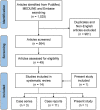Epidemiological, Clinical, and Trichoscopic Features of Syphilitic Alopecia: A Retrospective Analysis and Systematic Review
- PMID: 35586075
- PMCID: PMC9108265
- DOI: 10.3389/fmed.2022.890206
Epidemiological, Clinical, and Trichoscopic Features of Syphilitic Alopecia: A Retrospective Analysis and Systematic Review
Abstract
Background: Syphilitic alopecia (SA), which mimics other types of alopecia, is an uncommon manifestation of secondary syphilis. Trichoscopic features may facilitate its diagnosis. However, studies on SA and its trichoscopic characteristics remain limited.
Objective: To investigate the epidemiological, clinical, and trichoscopic findings and laboratory results, treatment, and outcomes of SA in Thai patients as well as to comprehensively summarize all trichoscopic features of SA through a systematic review.
Methods: Data on patients diagnosed with SA between December 2010 and December 2021 were obtained from their medical records and analyzed retrospectively. A systematic review of trichoscopic data, both from our institution and from studies registered in the PubMed, MEDLINE, and Embase databases, was conducted. A descriptive summarization was performed to comprehensively study the trichoscopic features of SA.
Results: Of the 205 patients with secondary syphilis, 23 patients with SA (symptomatic SA: 20, essential SA: 3) were included. The mean age was 27.6 ± 8.8 years, and male predominance was noted. The moth-eaten pattern was the most common SA presentation, and the parieto-occipital scalp was the most commonly affected area. All patients with SA achieved significant hair regrowth within 3 months of antibiotic therapy. Trichoscopic images were available for 20 patients with SA from our institute and were included in the systematic review. Fourteen articles provided information on 21 patients. Overall (N = 41), 26 (63.4%), 8 (19.5%), and 7 (17.1%) patients had moth-eaten alopecia, diffuse alopecia, and mixed alopecia, respectively. The most frequent trichoscopic finding was short regrowing hairs (78%), followed by decreased hair per follicular unit (75.6%), and empty follicles (51.2%). Unique features included flame hairs, bent tapering hairs, reddish-brown background, and brown rings around the perifollicular areas, each described in one case. However, the results were based only on case reports and small case series.
Conclusions: Given the progressively increasing frequency of SA, trichoscopic examination may be valuable when SA is suspected in patients with idiopathic alopecia; however, our findings are quite non-specific. The absence of exclamation mark hairs may help in the diagnosis of SA. Further comparative studies on other types of alopecia are required to determine the most useful diagnostic features.
Keywords: alopecia; alopecia syphilitica; dermoscopy; hair loss; moth-eaten; syphilis; treponema; trichoscopy.
Copyright © 2022 Pomsoong, Sukanjanapong, Ratanapokasatit and Suchonwanit.
Conflict of interest statement
The authors declare that the research was conducted in the absence of any commercial or financial relationships that could be construed as a potential conflict of interest.
Figures



Similar articles
-
Trichoscopic Features of Syphilitic Alopecia and Alopecia Areata: A Comparative Study.Clin Cosmet Investig Dermatol. 2023 Aug 17;16:2259-2269. doi: 10.2147/CCID.S424054. eCollection 2023. Clin Cosmet Investig Dermatol. 2023. PMID: 37608922 Free PMC article.
-
Syphilitic alopecia: uncommon trichoscopic findings.Dermatol Pract Concept. 2017 Jul 31;7(3):55-59. doi: 10.5826/dpc.0703a12. eCollection 2017 Jul. Dermatol Pract Concept. 2017. PMID: 29085722 Free PMC article.
-
Moth-eaten alopecia and beyond: Syphilitic alopecia - Revisited.Indian J Sex Transm Dis AIDS. 2024 Jul-Dec;45(2):144-147. doi: 10.4103/ijstd.ijstd_60_24. Epub 2024 Dec 13. Indian J Sex Transm Dis AIDS. 2024. PMID: 39886254 Free PMC article.
-
Trichoscopy of Tinea Capitis: A Systematic Review.Dermatol Ther (Heidelb). 2020 Feb;10(1):43-52. doi: 10.1007/s13555-019-00350-1. Epub 2020 Jan 6. Dermatol Ther (Heidelb). 2020. PMID: 31907867 Free PMC article. Review.
-
Trichoscopy of Androgenetic Alopecia: A Systematic Review.J Clin Med. 2024 Mar 28;13(7):1962. doi: 10.3390/jcm13071962. J Clin Med. 2024. PMID: 38610726 Free PMC article. Review.
Cited by
-
Alopecia as the initial presentation of secondary syphilis: A case report and review of literature.IDCases. 2025 Jul 9;41:e02314. doi: 10.1016/j.idcr.2025.e02314. eCollection 2025. IDCases. 2025. PMID: 40688427 Free PMC article.
-
Platelet-rich plasma in alopecia areata and primary cicatricial alopecias: A systematic review.Front Med (Lausanne). 2022 Nov 24;9:1058431. doi: 10.3389/fmed.2022.1058431. eCollection 2022. Front Med (Lausanne). 2022. PMID: 36507528 Free PMC article.
-
Trichoscopic Features of Syphilitic Alopecia and Alopecia Areata: A Comparative Study.Clin Cosmet Investig Dermatol. 2023 Aug 17;16:2259-2269. doi: 10.2147/CCID.S424054. eCollection 2023. Clin Cosmet Investig Dermatol. 2023. PMID: 37608922 Free PMC article.
-
Southern African HIV Clinicians Society Guideline for the clinical management of syphilis.South Afr J HIV Med. 2024 Apr 30;25(1):1577. doi: 10.4102/sajhivmed.v25i1.1577. eCollection 2024. South Afr J HIV Med. 2024. PMID: 38725703 Free PMC article.
-
A Three-Step Diagnostic Algorithm for Alopecia: Pattern Analysis in Trichoscopy.J Clin Med. 2025 Feb 12;14(4):1195. doi: 10.3390/jcm14041195. J Clin Med. 2025. PMID: 40004726 Free PMC article.
References
-
- Vafaie J, Weinberg JM, Smith B, Mizuguchi RS. Alopecia in association with sexually transmitted disease: a review. Cutis. (2005) 76:361–6. - PubMed
LinkOut - more resources
Full Text Sources

